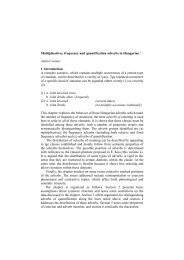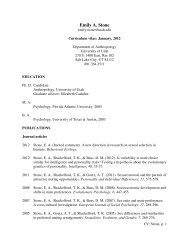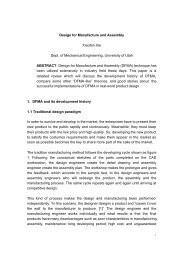DFMA as Applied to the Swingline 747 Desktop ... - University of Utah
DFMA as Applied to the Swingline 747 Desktop ... - University of Utah
DFMA as Applied to the Swingline 747 Desktop ... - University of Utah
Create successful ePaper yourself
Turn your PDF publications into a flip-book with our unique Google optimized e-Paper software.
<strong>DFMA</strong> <strong>as</strong> <strong>Applied</strong> <strong>to</strong> <strong>the</strong> <strong>Swingline</strong> ® <strong>747</strong> Desk<strong>to</strong>p Stapler<br />
will be used. Wea<strong>the</strong>r, temperature, soil acidity, and a host <strong>of</strong> o<strong>the</strong>r fac<strong>to</strong>rs may affect<br />
<strong>the</strong> lifetime <strong>of</strong> <strong>the</strong> product, which in turn can also affect <strong>the</strong> design. As w<strong>as</strong> mentioned,<br />
<strong>the</strong> optimal design for one <strong>as</strong>pect might be <strong>the</strong> le<strong>as</strong>t desirable for ano<strong>the</strong>r.<br />
One <strong>of</strong> <strong>the</strong> key material selection paradigms in <strong>DFMA</strong> is <strong>the</strong> derived parameter<br />
ranking. This enables <strong>the</strong> designers <strong>to</strong> rank each material depending on <strong>the</strong> desired<br />
property or ratios <strong>of</strong> related properties. According <strong>to</strong> <strong>the</strong> resulting data, proper selection<br />
<strong>of</strong> material can be better made.<br />
2.2 Material Selection – Stapler<br />
The full material selection data obtained by using <strong>DFMA</strong> equations is available in<br />
appendix A. Appendix B gives <strong>the</strong> selection criterion for <strong>DFMA</strong>. Table 3 gives a limited<br />
overview <strong>of</strong> <strong>the</strong> materials selection for each <strong>of</strong> <strong>the</strong> 17 primary parts <strong>of</strong> <strong>the</strong> <strong>747</strong> stapler. It<br />
is a brief presentation <strong>of</strong> what material <strong>DFMA</strong> suggests should be used for each part<br />
b<strong>as</strong>ed on different criteria. Some parts were not analyzed due <strong>to</strong> <strong>the</strong>ir apparent adequacy,<br />
i.e. no materials change w<strong>as</strong> deemed necessary. The column labeled analysis run<br />
indicates <strong>the</strong> criteria desired. The three subsequent columns give <strong>the</strong> material best suited<br />
for those criteria under certain conditions. For example, <strong>the</strong> rele<strong>as</strong>e clip analysis w<strong>as</strong> run<br />
<strong>to</strong> obtain <strong>the</strong> strongest beam. The material yielding <strong>the</strong> maximum performance is alloy<br />
steel. The minimum weight is achieved with aluminum. The minimum cost material is<br />
c<strong>as</strong>t iron. The variance <strong>of</strong> materials <strong>of</strong>fered by <strong>the</strong> analysis is indicative <strong>of</strong> <strong>the</strong> subjective<br />
nature <strong>of</strong> <strong>DFMA</strong>; sometimes a decision must be made when <strong>the</strong> data present conflicting<br />
results. The l<strong>as</strong>t column <strong>of</strong> Table 3 indicates what is believed <strong>to</strong> be <strong>the</strong> actual material <strong>of</strong><br />
which <strong>the</strong> part is made.<br />
10





